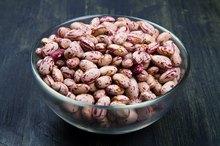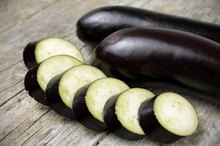What does fact checked mean?
At Healthfully, we strive to deliver objective content that is accurate and up-to-date. Our team periodically reviews articles in order to ensure content quality. The sources cited below consist of evidence from peer-reviewed journals, prominent medical organizations, academic associations, and government data.
The information contained on this site is for informational purposes only, and should not be used as a substitute for the advice of a professional health care provider. Please check with the appropriate physician regarding health questions and concerns. Although we strive to deliver accurate and up-to-date information, no guarantee to that effect is made.
Which Vegetables Are Not Good for Uric Acid?
Uric acid is a natural substance, but if your body produces too much, it may be bad for your health. Diet plays an important role in helping you manage high uric acid levels, and eliminating certain vegetables from your diet may be necessary. Consult your doctor to discuss your personal diet needs before making changes.
If you are experiencing serious medical symptoms, seek emergency treatment immediately.
Uric Acid Basics
Uric acid is a substance created in your body by the metabolism of purines, which are found in some of the foods you eat. Normally, uric acid gets dissolved in your blood and is excreted out of your body in urine.
If your body makes too much or can't get rid of it in urine, however, blood uric acid levels rise. Too much uric acid in the blood can cause kidney stones or gout, a painful arthritis characterized by uric acid crystals that settle in the joints.
- Uric acid is a substance created in your body by the metabolism of purines, which are found in some of the foods you eat.
- Too much uric acid in the blood can cause kidney stones or gout, a painful arthritis characterized by uric acid crystals that settle in the joints.
Vegetables to Limit
List of Foods That Reduce Uric Acid
Learn More
Certain vegetables contain high amounts of purines, and limiting your intake of these vegetables is recommended when trying to reduce uric acid levels. High-purine vegetables include mushrooms, asparagus, spinach and cauliflower. Legumes, such as beans, peas and lentils, are also high in purines.
To keep uric acid levels within an acceptable range, eat no more than two servings of the high-purine vegetables, including the legumes, a week, says the University of Pittsburgh Medical Center 1. One serving is equal to 1/2 cup of cooked veggies or 1 cup raw.
- Certain vegetables contain high amounts of purines, and limiting your intake of these vegetables is recommended when trying to reduce uric acid levels.
- To keep uric acid levels within an acceptable range, eat no more than two servings of the high-purine vegetables, including the legumes, a week, says the University of Pittsburgh Medical Center 1.
Better Choices
All other vegetables, including carrots, cucumbers, green beans, squash and kale, make acceptable choices when trying to reduce uric acid levels in the blood, according to the medical center. Aim for three servings a day.
Upping your intake of vitamin C-rich vegetables may help lower uric acid levels, according to the website Patient. Vegetables high in vitamin C include red and green peppers, broccoli, potatoes, brussels sprouts and tomatoes.
- All other vegetables, including carrots, cucumbers, green beans, squash and kale, make acceptable choices when trying to reduce uric acid levels in the blood, according to the medical center.
Additional Diet Recommendations
Can Certain Vegetables Increase Your White Blood Cells?
Learn More
Limiting your intake of other foods may also help keep uric acid levels within an acceptable range. Meats, poultry and seafood are the primary sources of purines in the diet, and it is recommended that you limit your intake of these foods to 3 ounces twice a day. Use caution with broths made from meats, as well. Don't take baker's or brewer's yeast as a supplement, suggests the University of Pittsburgh Medical Center 1.
Eating more vitamin-C rich fruit, such as kiwi, strawberries and oranges, may also help bring down your uric acid numbers. Additionally, try to drink plenty of water, about 8 to 12 cups a day, to help prevent kidney stones.
- Limiting your intake of other foods may also help keep uric acid levels within an acceptable range.
- Eating more vitamin-C rich fruit, such as kiwi, strawberries and oranges, may also help bring down your uric acid numbers.
Related Articles
References
- University of Pittsburgh Medical Center: Low-Purine Diet
- Patient: Gout Diet Sheet
- MedlinePlus: Uric Acid
- Office of Dietary Supplements: Vitamin C
- Benn CL, Dua P, Gurrell R, et al. Physiology of hyperuricemia and urate-lowering treatments. Front Med (Lausanne). 2018;5:160. doi:10.3389/fmed.2018.00160
- George C, Minter DA. Hyperuricemia. [Updated 2019 Jun 4]. In: StatPearls [Internet]. Treasure Island (FL): StatPearls Publishing; 2019 Jan-.
- Ramirez-Sandoval JC, Madero M. Treatment of hyperuricemia in chronic kidney disease. Contrib Nephrol. 2018;192:135-146. doi: 10.1159/000484288
- Wilson FP, Berns JS. Tumor lysis syndrome: new challenges and recent advances. Adv Chronic Kidney Dis. 2014;21(1):18–26. doi:10.1053/j.ackd.2013.07.001
- American Association for Clinical Chemistry. Uric acid. Reviewed May 17, 2017.
- Khanna D, Fitzgerald JD, Khanna PP, et al. 2012 American College of Rheumatology guidelines for management of gout. Part 1: systematic nonpharmacologic and pharmacologic therapeutic approaches to hyperuricemia. Arthritis Care Res (Hoboken). 2012;64:1431–46. doi: 10.1002/acr.21772
- Coburn BW, Bendlin KA, Sayles H, et al. Target serum urate: Do gout patients know their goal? Arthritis Care Res (Hoboken). 2016;68(7):1028-35. doi:10.1002/acr.22785
- Wiederkehr MR, Moe OW. Uric acid nephrolithiasis: a systemic metabolic disorder. Clin Rev Bone Miner Metab. 2011;9(3-4):207–217. doi:10.1007/s12018-011-9106-6
Writer Bio
Jill Corleone is a registered dietitian and health coach who has been writing and lecturing on diet and health for more than 15 years. Her work has been featured on the Huffington Post, Diabetes Self-Management and in the book "Noninvasive Mechanical Ventilation," edited by John R. Bach, M.D. Corleone holds a Bachelor of Science in nutrition.









